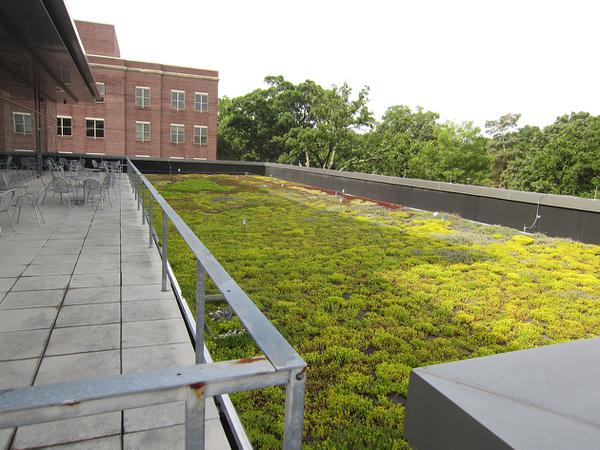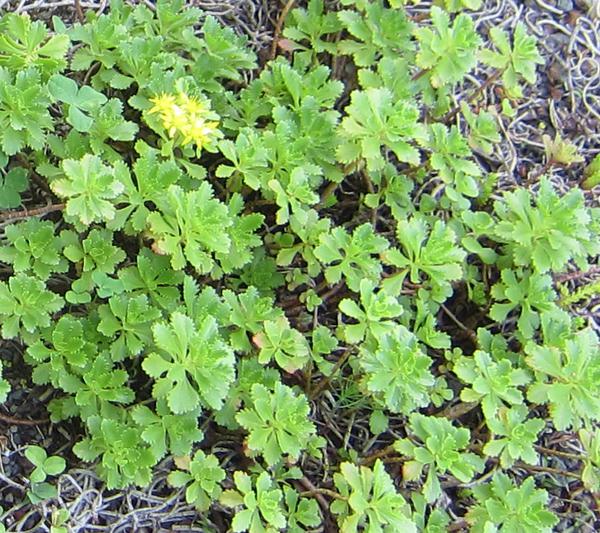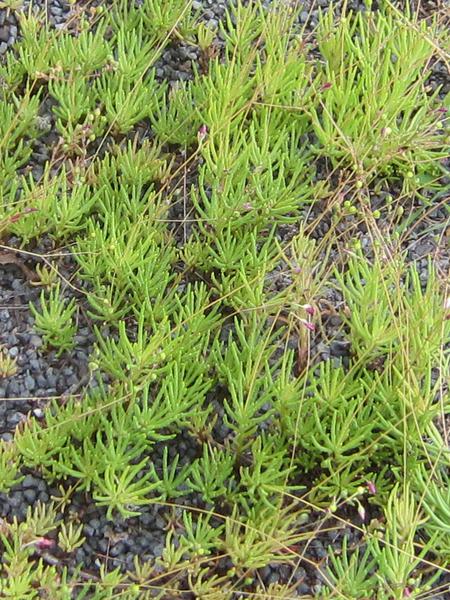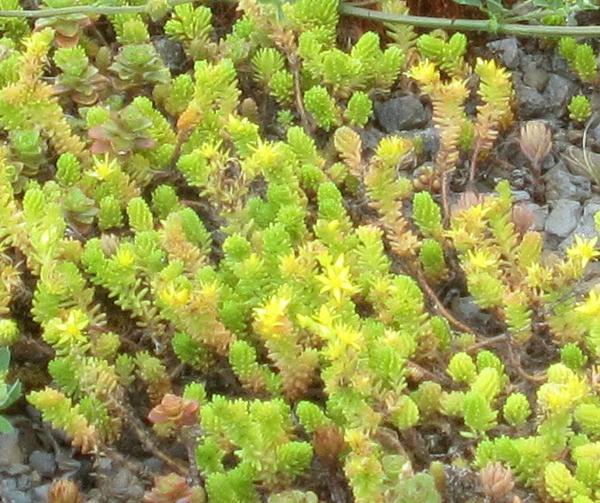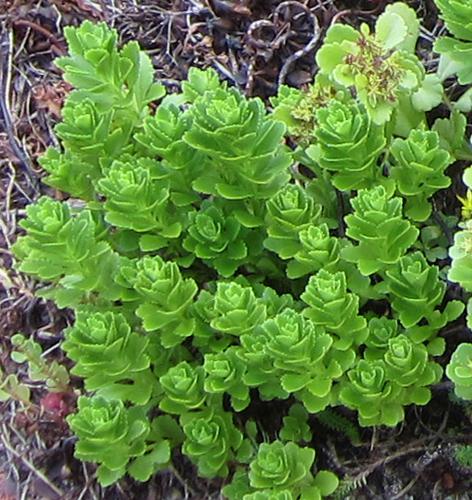In the Research Triangle area of North Carolina green roofs have been designed, installed, planted, and maintained with varying levels of plant survival and vigor. This publication describes the metrics used in 2015 to evaluate plant survival and vigor on 11 extensive green roofs and provides plant selection guidelines for future installations.
Green Roofs
A green roof or living roof is partially or completely covered with vegetation, which is installed over a waterproofing membrane (Figure 1). Green roofs are used to improve stormwater management, reduce environmental pollutants, lower building energy costs, extend roof lifespan, and improve the aesthetic characteristics of urban spaces.
Types of Green Roofs
There are two types of green roofs — intensive and extensive — distinguished by the planting substrate depth. Extensive green roofs have a planting substrate depth that is 6 inches (15.2cm) or less. In contrast, intensive green roofs have substrate depths greater than 6 inches. While the greater substrate depth of intensive roofs can provide improved plant growth and support a greater diversity of plants, these roofs have more structural requirements and greater up-front construction costs as well as higher maintenance costs as compared to extensive green roofs. In the Southeastern United States, extensive green roofs are more common than intensive roofs as a result of fewer total system costs and the ability to still provide the desired ecosystem functions (Getter and Rowe 2006).
Reported Benefits of Extensive Green Roofs
Environmental Impacts
Extensive green roofs have been shown to reduce stormwater runoff volume by 30% to 86%, and peak flow rates by 22% to 93%, and can delay the peak flow by up to 30 minutes. Further, Li, Babcock, and Roger (2014) asserted that green roofs decrease pollution, flooding, and erosion during precipitation events. Extensive green roofs also reduce the urban heat island effect, in which urban areas are significantly warmer than their surrounding rural areas due to human activities (Santamouris 2014). Other environmental benefits include air purification (Rowe 2011; Yang et al. 2008), carbon sequestration (Getter et al. 2009), noise reduction (Veisten et al. 2012), and increased biodiversity (Gedge and Kadas 2005).
Economic impacts
The economic benefits of green roofs are hotly debated. Niachou et al. (2012) compared the insulative performance of 12 extensive green roofs and found that the buildings with an extensive green roof that were also well-insulated had only a 2% energy savings, but the buildings with a green roof that were not also insulated exhibited an energy savings of 37 to 48%. Additionally, while green roofs can cost as much as 30% more than traditional roofs to construct, the life span of an extensive green roof can be double that of a traditional roof. In addition, green roofs may last more than 40 years, which offsets the initial difference in construction cost (Taylor 2015).
Social-Cultural Impacts
Green roofs benefit institutional and commercial zones by attracting public attention and possibly by influencing governmental policy regarding energy, climate change, and the environment. Though research investigating human health effects is ongoing, Tzoulas et al. (2007) indicated that green roofs, as part of urban green infrastructures, play an important role in improving socio-economic health, community health, physical health, and psychological health.
Importance of Plant Selection on Extensive Green Roofs
Selecting plant cover is an essential component of optimizing green roof benefits such as: reduced heat island effects, improved thermal insulation, and enhanced stormwater mitigation (Jones et al. 2011). For example, vegetation types may influence the amount of water runoff from extensive green roofs. Grasses are more effective than forbs or sedums for reducing water runoff (Nagase and Dunnett 2012), yet most grasses are poorly adapted to extensive green roofs in the Southeastern United States.
Plant Selection Criteria
The environmental conditions on extensive green roofs are harsh, with fluctuations in soil moisture, temperature, and wind speed, which can generate high evapotranspiration rates. Consequently, extensive green roof plants must have the following characteristics:
- shallow root systems;
- tolerance of direct sunlight, drought, frost, and high winds;
- ability to regenerate;
- ease of propagation;
- rapid establishment; and
- high ground cover density.
Cultivated plant species that meet these criteria have traditionally been limited to a few herbs, grasses, mosses, and drought-tolerant succulents such as sedum (Getter and Rowe 2006).
Recommended Plant Species for Green Roofs in the Research Triangle Area
Limited information is available on plant survival and adaptability to green roofs in the Southeastern United States. Moran (2014) compared 10 species for survival and growth on extensive green roof construction in eastern and central North Carolina. From this study she recommended these seven plant species for use: Delosperma nubigenum, Sedum album, S. album ‘Murale,’ S. floriferum, S. reflexum, S. sexangulare, and S. spurium ‘Fuldaglut.’ These plants demonstrated 60% to 75% coverage in her trials. Based on data from this and other reports, most green roofs in the area are planted with a mixture of sedum species, but no reports were available on the establishment and growth of plants on roofs in this area.
In 2015 we evaluated plant cover on 11 extensive green roofs in the Research Triangle area. We documented the desirable and undesirable plant species on each roof. Evaluators estimated the percentage of ground cover of each species and the percentage of bare ground. We observed considerable differences in the desirable plant cover. Among the 11 sites, plant cover ranged from 26% to 82%, with an overall average of 53% desirable plant cover. Only two sites had desirable plant cover of 70% to 80%; five sites had 50% to 70% cover; and four sites had only 25% to 50% cover. The four species with the greatest presence, survival, and overall growth were Sedum kamtschaticum ‘Weihenstephaner Gold’ (Figure 2), Talinum calycinum (fame flower) (Figure 3), Sedum sexangulare (Figure 4), and Sedum spurium ‘Album Superbum’ (Figure 5) See Table 1.
It is important to point out that there were poorly performing plants on our study roofs, including: Sedum album ‘Chubby Fingers,’ Sedum album ‘Coral Carpet,’ Sedum reflexum ‘Blue Spruce,’ Sedum spectabile ‘Autumn Joy,’ Sedum spurium ‘Dragon’s Blood,’ and Sedum ternatum.
| Genus | Number of roofs with species present | Percent cover | ||
| Average | Low | High | ||
| Sedum kamtschaticum ‘Weihenstephaner Gold’ | 9 | 28.5% | 0.6% | 64.0% |
| Sedum spurium ‘Album Superbum’ | 2 | 18.6% | 0.4% | 51.5% |
| Sedum sexangulare | 4 | 16.2% | 1.3% | 27.1% |
| Talinum calycinum | 5 | 10.1% | 2.0% | 25.4% |
| Sedum spurium ‘Dragon’s Blood’ | 7 | 3.3% | 0.4% | 8.3% |
| Sedum album ‘Chubby Fingers’ | 7 | 2.7% | 0.2% | 7.9% |
| Sedum reflexum ‘Blue Spruce’ | 2 | 3.1% | 0.2% | 6.0% |
| Sedum album ‘Coral Carpet’ | 3 | 3.0% | 0.2% | 5.8% |
| Sedum spectabile ‘Autumn Joy’ | 2 | 3.3% | 2.3% | 4.3% |
| Sedum ternatum | 2 | 0.7% | 0.6% | 0.9% |
Considerations
The four hardiest or best-adapted species established well on the extensive green roofs we studied. Yet more research is needed to evaluate plants that have the potential to be successful on extensive green roofs across the Southeastern United States. We recommend planting a diversity of adapted species and varieties to increase the likelihood of plant survival. A diversity of sedums appears to be the most widely adapted plants, but other species should be considered, too, such as Talinum calycinum (fame flower), which was one of the more successful plants on our study sites.
Additionally, plants should be chosen according to the main function of the extensive green roof, whether it be environmental, economic, or socio-cultural. If the extensive green roof is highly visible, well-adapted plants should be chosen with high aesthetic value. If the extensive green roof is built mainly for ecological functions like stormwater management, species other than sedums should be considered. Although grasses have been shown to provide greater stormwater benefits than sedums, it is important for researchers to study the use and performance of both forbs and grasses on green roofs in the Southeastern United States.
Recommended Resources
Websites
A Guide for Building Green Roofs in Chicago
Green Roof Service LLC / Green Roof Technology
American Society of Landscape Architects, Green Roof
Michigan State University Green Roof Research
North Carolina State University
- Permeable Pavements, Green Roofs, and Cisterns
- Stormwater Engineering Group
- A North Carolina Field Study to Evaluate Greenroof Runoff Quantity, Runoff Quality, and Plant Growth
Penn State College of Agricultural Sciences
University of Georgia
University of Illinois at Chicago
- Office of Sustainability
University of Sheffield
University of Toronto
Books
McIntyre, L. and E. C. Snodgrass. 2010. The Green Roof Manual: A Professional Guide to Design, Installation, and Maintenance. Timber Press, Portland, OR.
Spiegel, R. and D. Meadows. 2010. Green Building Materials: A Guide to Product Selection and Specification. 3rd ed. Wiley, New York, N.Y.
Weiler, S. and K. Scholz-Barth. 2009. Green Roof Systems: A Guide to the Planning, Design, and Construction of Landscapes over Structure. Wiley, New York, N.Y.
References and Other Resources
References
Gedge, D., and G. Kadas. 2005. "Green Roofs and Biodiversity." Biologist 52:161-169.
Getter, K. L., D. B. Rowe, G. P. Robertson, B. M. Cregg, and J. A. Andresen. 2009. "Carbon Sequestration Potential of Extensive Green Roofs." Environ. Sci. Technol. 43:7564-7570.
Getter, K. L. and D. B. Rowe. 2006. "The Role of Extensive Green Roofs in Sustainable Development." HortScience 41:1276-1285.
Jones, E., T. Miller, J. Monsma, J. Puszykowski, and J. Westphal. 2011. "What Happens to Plant Cover and Species Diversity When an Extensive Green Roof System Is Tilted? A Case Study on Green Roof Design, Old Mission Peninsula, Michigan." Mich. Acad. 40:175:175-196.
Li, Y., J. Babcock, and W. Roger. 2014. "Green Roof Hydrologic Performance and Modeling: A Review." Water Science and Technology: A Journal of the International Association on Water Pollution Research 69:727-738.
Moran, A., W. F. Hunt, and D. G. Jennings. 2014. A North Carolina Field Study to Evaluate Greenroof Runoff Quantity, Runoff Quality, and Plant Growth. PhD Diss. North Carolina State University, Department of Biological and Agricultural Engineering.
Nagase, A., and N. Dunnett. 2012. "Amount of Water Runoff from Different Vegetation Types on Extensive Green Roofs: Effects of Plant Species, Diversity, and Plant Structure." Landscape Urban Plann. 104:356-363.
Niachou, A., K. Papakonstantinou, M. Santamouris, A. Tsangrassoulis, and G. Mihalakakou. 2012. "Analysis of the Green Roof Thermal Properties and Investigation of its Energy Performance." Energy & Buildings 33:719-729.
Rowe, D. B. 2011. "Green Roofs as a Means of Pollution Abatement." Environmental Pollution 159:2100-2110.
Santamouris, M. 2014. "Cooling the Cities - A Review of Reflective and Green Roof Mitigation Technologies to Fight Heat Island and Improve Comfort in Urban Environments." Solar Energy 103:682-703.
Taylor, M., 2015. "What a Green Roof Costs You on the Way to Saving Everything." MainStreet.com. https://www.mainstreet.com/article/what-a-green-roof-costs-you-on-the-way-to-saving-everything.
Tzoulas, K., K. Korpela, S. Venn, V. Yli-Pelkonen, A. Kaźmierczak, J. Niemela, and P. James. 2007. "Promoting Ecosystem and Human Health in Urban Areas Using Green Infrastructure: A Literature Review." Landscape Urban Plann. 81:167-178.
Veisten, K., Y. Smyrnova, R. Klæboe, M. Hornikx, M. Mosslemi, and J. Kang. 2012. "Valuation of Green Walls and Green Roofs as Soundscape Measures: Including Monetised Amenity Values Together with Noise-Attenuation Values in a Cost-Benefit Analysis of a Green Wall Affecting Courtyards." International Journal of Environmental Research and Public Health 9:3770-3770.
Yang, J., Q. Yu, and P. Gong. 2008. "Quantifying Air Pollution Removal by Green Roofs in Chicago." Atmos. Environ. 42:7266-7273.
Other Resources
Castleton, H. F., V. Stovin, S. B. M. Beck, and J. B. Davison. 2010. "Green Roofs; Building Energy Savings and the Potential for Retrofit." Energy & Buildings 42: 1582-1591.
Getter, K. L., R. D. Bradley, and B. M Cregg. 2009. "Solar Radiation Intensity Influences Extensive Green Roof Plant Communities." Urban Forestry & Urban Greening 8:269-281.
Getter, K. L. and D. B. Rowe. 2009. "Substrate Depth Influences Sedum Plant Community on a Green Roof." HortScience 44:401-407.
Graceson, A., J. Monaghan, N. Hall, and M. Hare. 2014. "Plant Growth Responses to Different Growing Media for Green Roofs." Ecol. Eng. 69:196-200.
Gregoire, B. G., and J. C. Clausen. 2011. "Effect of a Modular Extensive Green Roof on Stormwater Runoff and Water Quality." Ecol. Eng. 37:963-969.
Heim, A., and J. Lundholm. 2014. "The Effects of Substrate Depth Heterogeneity on Plant Species Coexistence on an Extensive Green Roof." Ecol. Eng. 68:184-188.
More, T. C., and W. F. Hunt. 2013. "Predicting the Carbon Footprint of Urban Stormwater Infrastructure." Ecol. Eng. 58:44-51.
Nagase, A., and N. Dunnett. 2011. "The Relationship Between Percentage of Organic Matter in Substrate and Plant Growth in Extensive Green Roofs." Landscape Urban Plann. 103:230-236.
Saadatian, O., K. Sopian, E. Salleh, C. Lim, S. Riffat, E. Saadatian, A. Toudeshki, and M. Sulaiman. 2013. "A Review of Energy Aspects of Green Roofs." Renewable & Sustainable Energy Reviews 23:155-168.
Whittinghill, L., D. Rowe, and B. Gregg. 2013. "Evaluation of Vegetable Production on Extensive Green Roofs." Agroecology and Sustainable Food Systems 37:465-484.
Wong, N. H., D. K. W. Cheong, H. Yan, J. Soh, C. L. Ong, and A. Sia. 2003. "The Effects of Rooftop Garden on Energy Consumption of a Commercial Building in Singapore." Energy & Buildings 35:353-364.
Publication date: March 6, 2017
AG-829
N.C. Cooperative Extension prohibits discrimination and harassment regardless of age, color, disability, family and marital status, gender identity, national origin, political beliefs, race, religion, sex (including pregnancy), sexual orientation and veteran status.

